Here in late April, it’s about time to water my deciduous fruit trees for the first time since winter. I water most of my fruit trees — both deciduous and citrus and avocado — using micro-sprinklers. Micro-sprinklers are small emitters that work on low water pressure and the same tubes as drip irrigation, but instead of dripping, micro-sprinklers spit, spray, emit fans or jets of water, or spin and sprinkle water in broader patterns.
I’ve had good results watering trees with micro-sprinklers, and in this post I want to share how I’ve found it best to place and configure these micro-sprinklers under fruit trees, including which types of micro-sprinklers I prefer for different situations, as well as modifications I make to them.
Why water fruit trees with micro-sprinklers?
If you’re wondering why one would choose to water fruit trees with micro-sprinklers in the first place, very briefly, the advantages compared to drip include being easier to adjust as trees grow bigger, and that there’s a larger wetting pattern so trees are more resilient in heat or drought. And as with drip, micro-sprinklers are a method of irrigation that applies a small amount of water at a time so they are an excellent choice for trees on slopes because there will be no need for basins and still no runoff — even less than with drip.
Where to place micro-sprinklers
So before needing to irrigate, I’m giving things a run through, starting the sprinklers spinning to make sure they’re working after months of winter idleness.
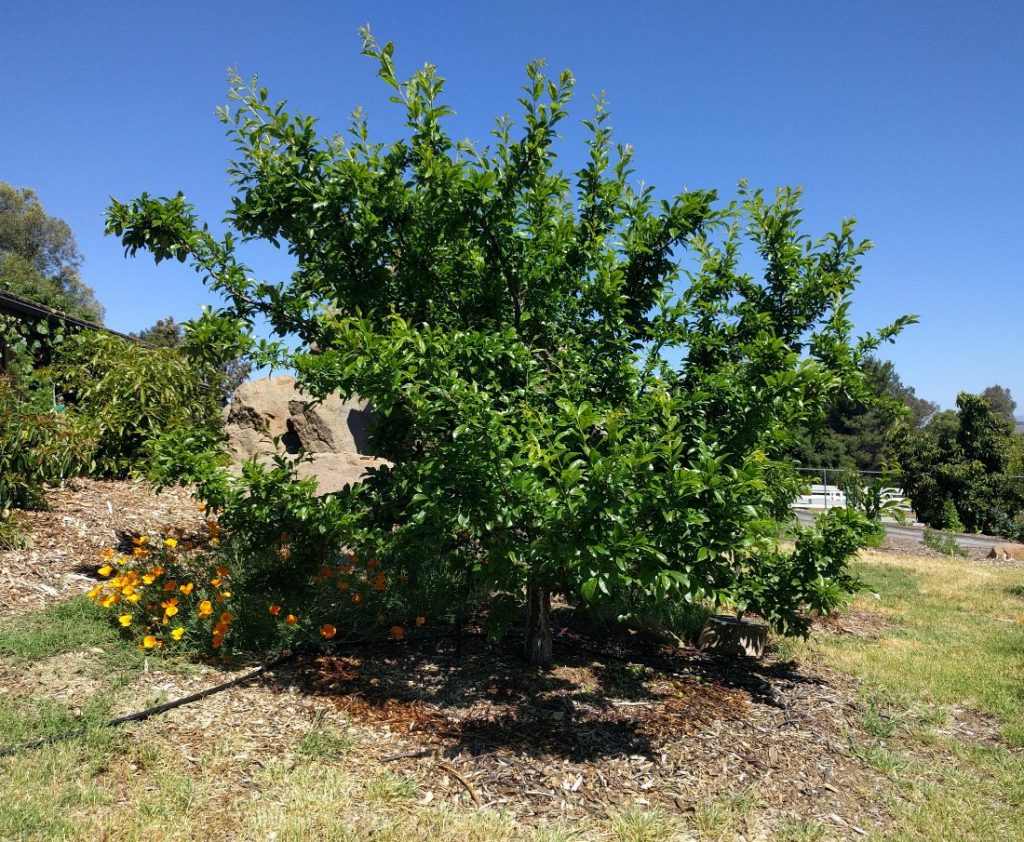
Spinning just fine. Putting down a band of water under the canopy of this Dapple Dandy pluot tree.
Brightening up the shade under the canopy, you can notice where the micro-sprinkler is located:
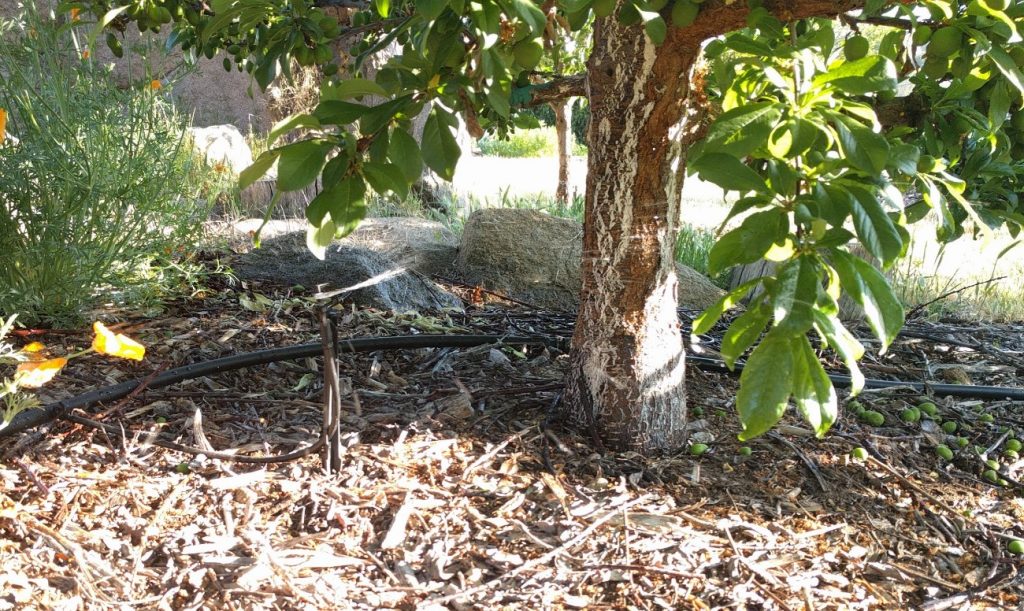
Uphill from the tree. The reason for that is there is always a certain amount of water that dribbles down the micro-sprinkler and its stake instead of spraying outward. I want that leaky water to go into the soil uphill from the tree so that it is not running or percolating away from the tree but rather toward the tree (roots).
Second, the micro-sprinkler’s stake is inserted about a foot (a shovel’s length) away from the trunk. Closer to the trunk and the trunk would block much of the spraying water. Farther away and the spray will not be able to cover as much of the ground directly under the tree.
The particular micro-sprinkler used on this tree is made by an Australian company called Antelco and it has a wedge on one side, as seen on the right side of this photo:
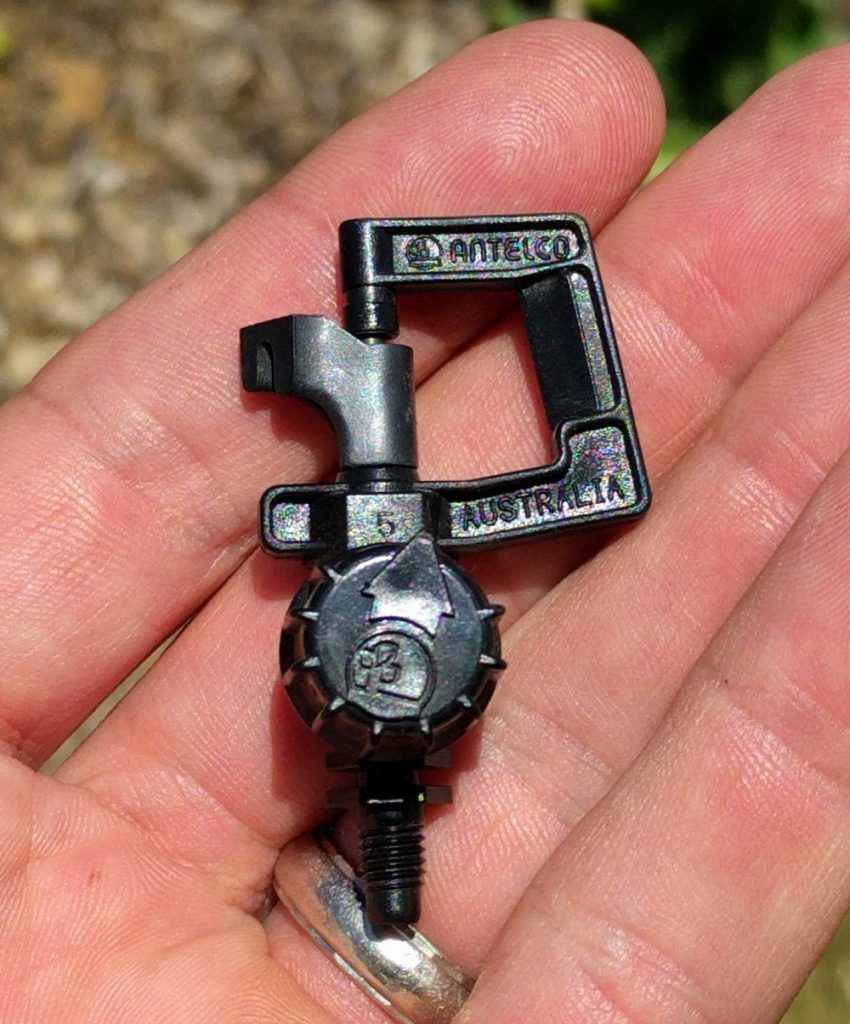
You can aim the wedge toward the trunk of the tree, and the wedge splits the sprinkles of water essentially creating a pie-shaped dry area so that the trunk is not wetted. This is good because if you water often and you’re wetting the trunk, then you are creating the conditions that crown-rotting organisms thrive in. Also, trees prefer to drink from small roots growing farther away from their trunk.
When using a micro-sprinkler that doesn’t have a wedge, you can place a stick between the sprinkler and trunk to deflect water and keep the trunk mostly dry.
(For more on the topic of wetting tree trunks, see my post “Keep mulch away from tree trunks?”)
So that’s where I place micro-sprinklers under my fruit trees, but some people prefer to place sprinklers between trees, for example . . .
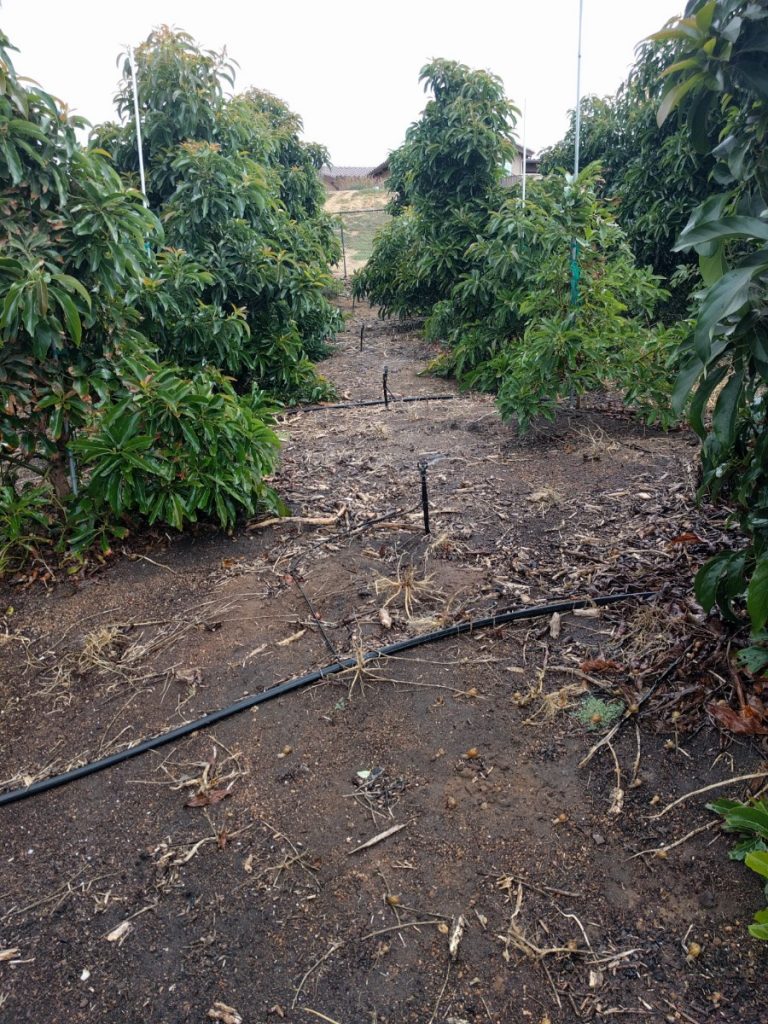
Look at all that bare ground that has been wetted, that is unlikely to have many roots underneath, and that is surely very prone to evaporation. This can be a less efficient way to irrigate unless trees are large and close together.
But I also don’t place micro-sprinklers between trees because the micro-sprinklers would be in the walking path, plus it inhibits your ability to water each tree individually.
I like to grow many fruit trees but I have a water budget so each of my trees has its own micro-sprinkler that I tune to apply water to that tree as efficiently as I know how.

Adjustment valves
An indispensible component of watering fruit trees efficiently with micro-sprinklers is having adjustment valves. Some micro-sprinklers have adjustment valves built in. Here’s that Antelco micro-sprinkler with the wedge again:

That dial on the bottom controls a valve that allows more or less water through. But you can also insert adjustment valves into the feeder tubing of any micro-sprinkler. This is what I usually do. Here are the adjustment valves that I buy (available at any irrigation or home improvement store):
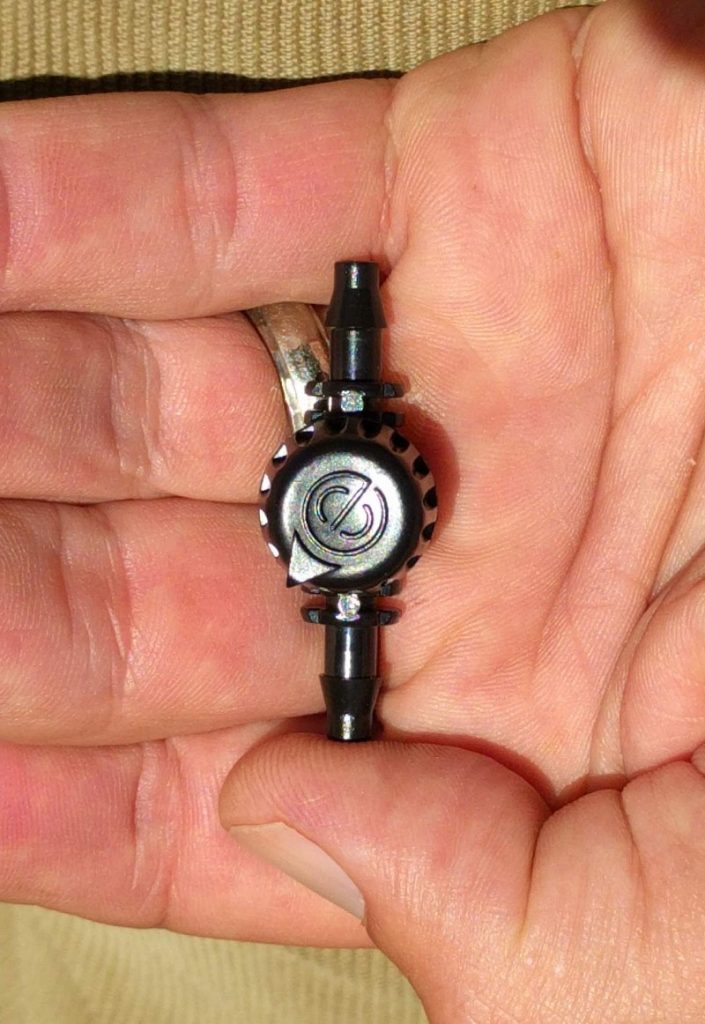
And here is one of those adjustment valves inserted into the tubing of a micro-sprinkler:
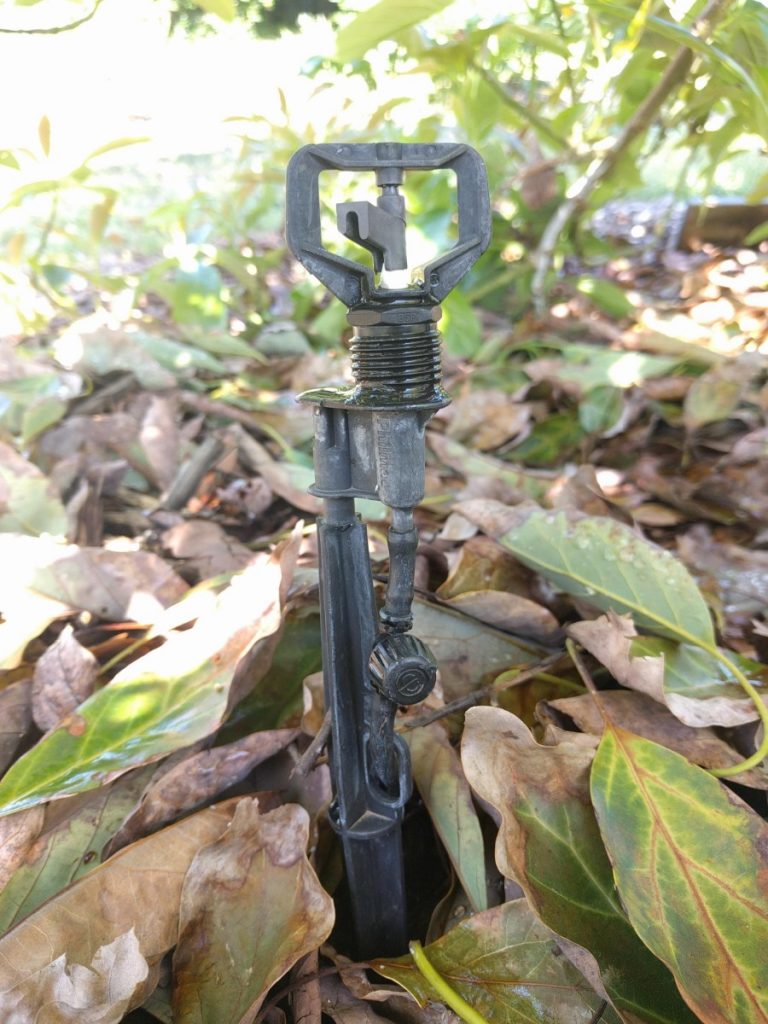
This allows you to adjust the output of each micro-sprinkler according to each tree’s needs so that you can water trees of different ages and sizes all at the same time while giving each your best guess of how much water they need.
Small new trees
This is another pluot tree, a Flavor Grenade variety, planted in January as a bare root. So it’s been in the ground for only about four months, and I’ve yet to install irrigation to it.
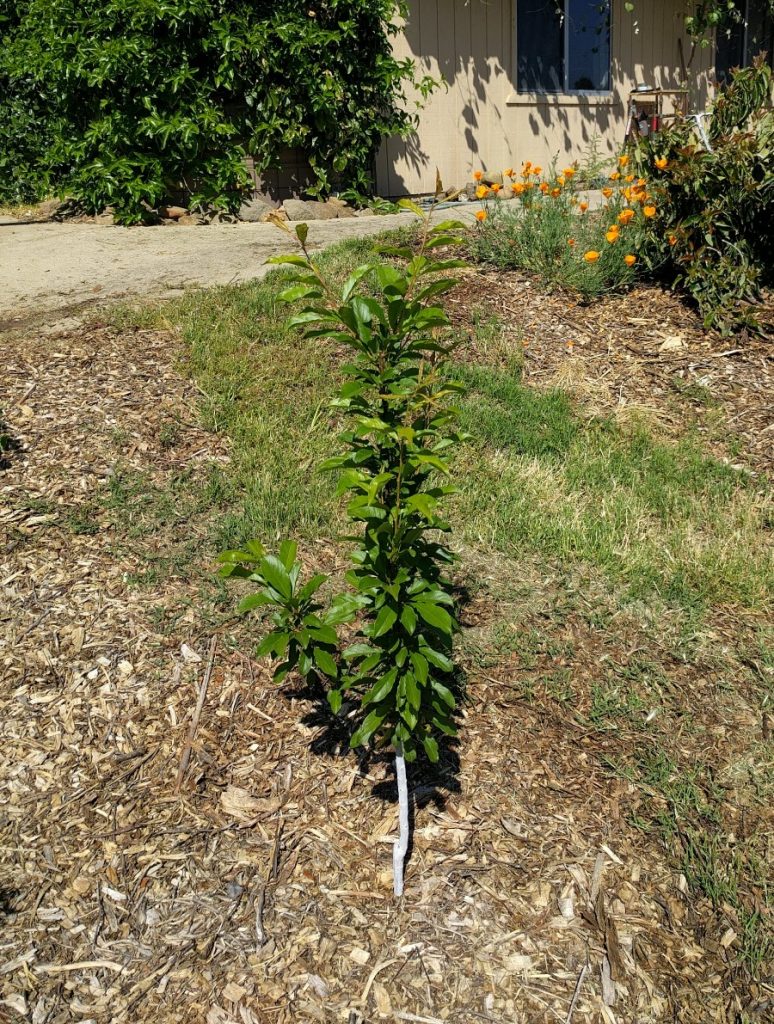
I now need to set up a micro-sprinkler under this tree. Unfortunately, I can’t use one of the Antelco micro-sprinklers shown above. Here is what happens if you try to water a small tree with a spinning micro-sprinkler:
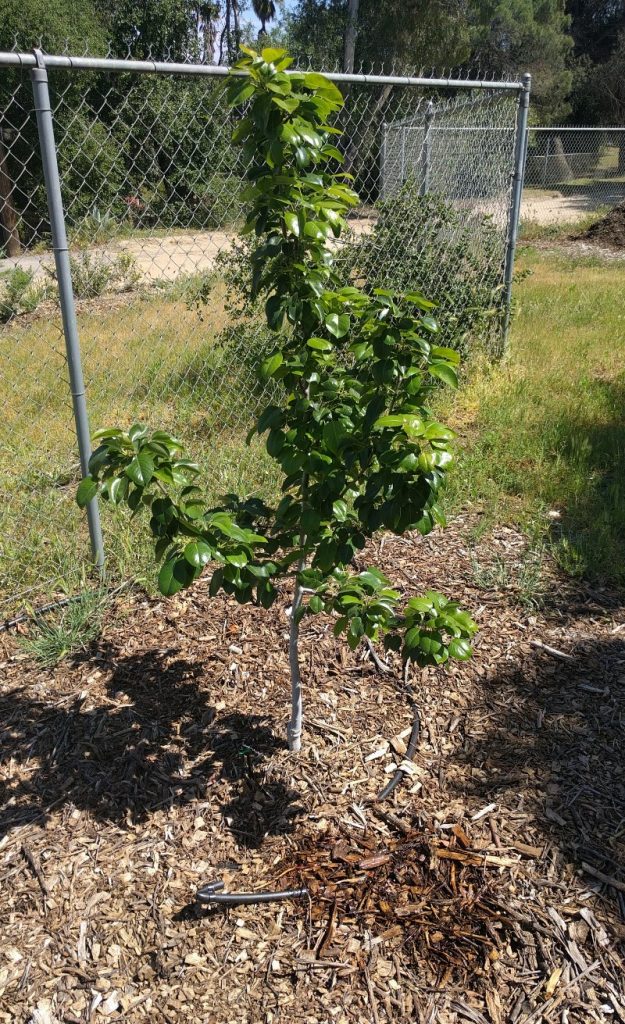
Spinning micro-sprinklers need a certain amount of pressure in order to revolve properly. If the pressure is too low, they don’t spin and just shoot a single stream of water as in the photo above. But if you open the adjustment valve to increase the pressure and get them spinning, they shoot water too far away, beyond the root zone of such a small tree.
So spinners are best used on bigger trees where you want the micro-sprinkler to cover a larger area of ground, at least five feet in diameter, as wide as your wingspan, is my rule of thumb.
For small trees, such as the Flavor Grenade pluot, I use micro-sprinklers that spit.

Makes and models of micro-sprinklers
Luckily, there are a few manufacturers of micro-sprinklers that make products with interchangeable spitting and spinning fixtures. The one I installed on the Flavor Grenade is made by DIG, a company based in San Diego County. This micro-sprinkler comes with three spitting fixtures in addition to a spinning fixture. Here is a pack of the DIG multi-head micro-sprinklers:
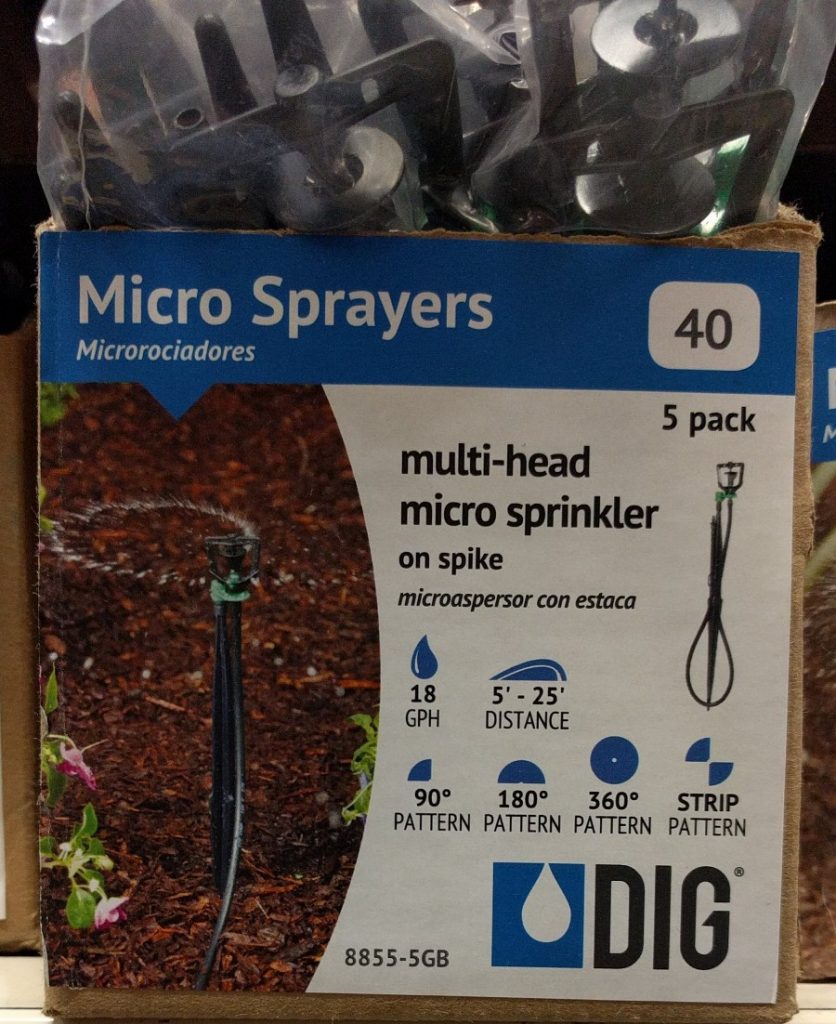
And here it is running under the Flavor Grenade pluot tree:

You’ll notice that the wetting pattern is not exactly a circle but a more of a clamshell shape. This is done with the 180-degree fixture (red), which I use on most small trees.
After a couple years, once the tree’s canopy is about five feet in diameter, all I do is switch out the 180-degree fixture for the spinning fixture. It’s a five-second job, and it doesn’t require purchasing anything new. Now I’ve got a micro-sprinkler that spins and applies water in a circle under the tree, just as with the Antelco micro-sprinkler used on that Dapple Dandy pluot tree shown earlier.
Big trees
I keep most of my fruit trees small though. I’ve found that the DIG multi-head micro-sprinkler works well up to a diameter of about 15 feet. Beyond that, it gets susceptible to wind.
Why? It’s all about droplet size. The DIG multi-head micro-sprinkler has a relatively small orifice that pushes out small droplets. The farther you ask small droplets to travel, the more they become wafted into the atmosphere.
For fruit trees that are larger than 15 feet, micro-sprinklers with larger orifices and bigger droplets work better at getting water onto the soil and down to the roots.
DIG makes micro-sprinklers with larger orifices, and I’m sure they work well, but I’ve always used micro-sprinklers made by Antelco and Philmac for larger trees.
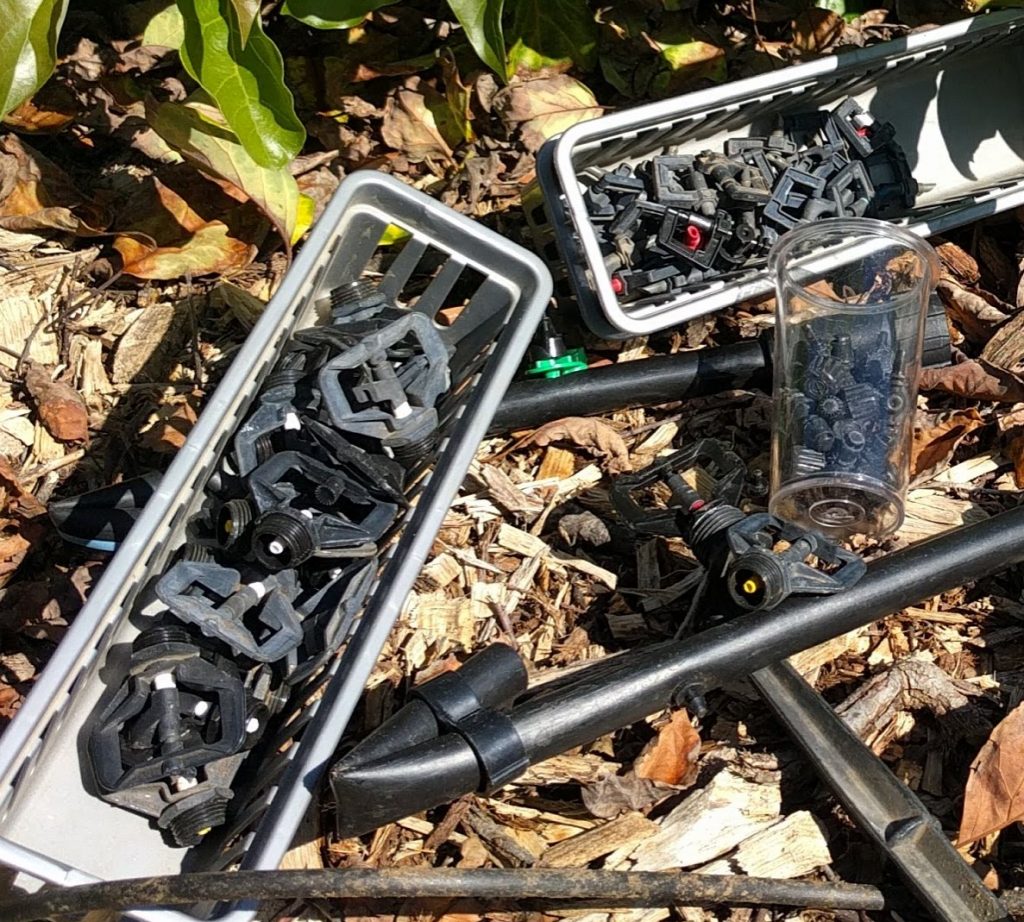
If you are watering a tree with a diameter greater than 15 feet or if you live in a windy place, go with a micro-sprinkler with an orifice close to a tenth of an inch in size. For example, the red Philmac has an orifice of 0.094 inches and its droplets are big and very stable in a breeze.
Where to buy micro-sprinklers?
Find where DIG micro-sprinklers are sold here. I have bought mine at Home Depot.
View Philmac micro-sprinklers here. I have bought mine at Grangetto’s, which has four locations in San Diego County.
I’ve also bought Antelco micro-sprinklers at Grangetto’s. You can also order them online from Drip Depot.
Note: Both Philmac and Antelco also make micro-sprinklers that have interchangeable spitting and spinning fixtures, and they work great.
Video showing micro-sprinklers under avocado trees
This shows how I use micro-sprinklers under my avocado trees specifically, but even under my apricots or oranges or apples I configure and run micro-sprinklers almost the same.
Happy Irrigation Season! I wish you a good watering year, and if micro-sprinklers are involved, then may yours spin to satisfaction.
All of my Yard Posts are listed HERE

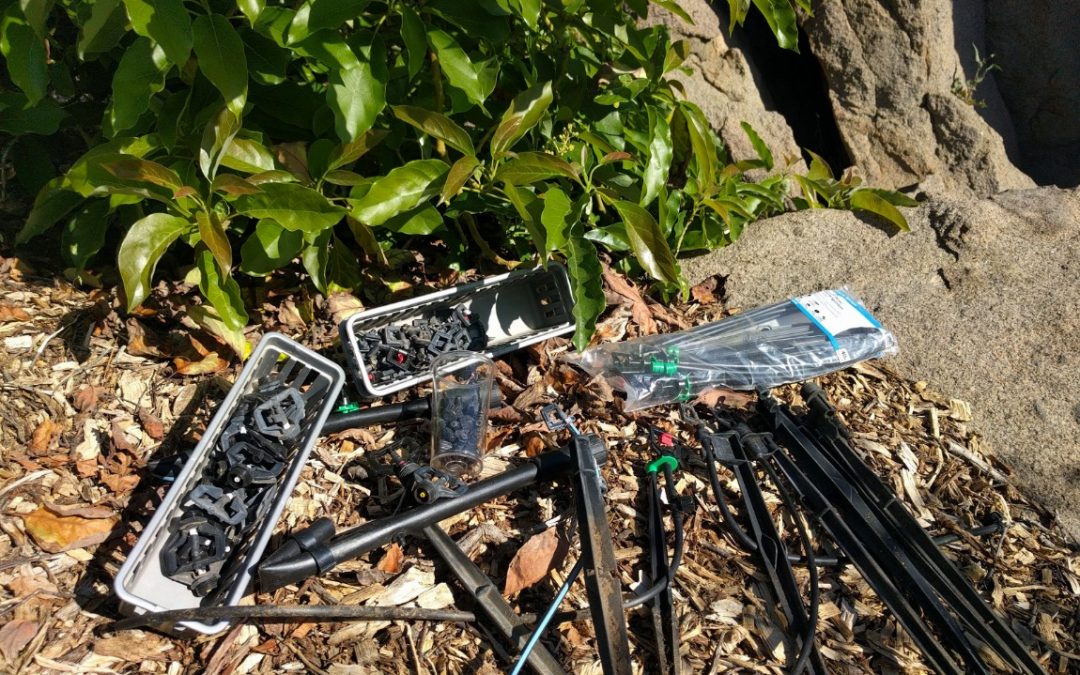


Friend of mine keeps pushing me to use small pipes with diffusion holes dug into the ground. What do you think of those? Also, after the first year with an avocado tree, should I be aiming the watering at the tree line only, or is it important to get the area between that and the trunk wet too?
Hi Bruce,
Those pipes seem to work fine for certain trees. I’ve never used them on avocados. I have seen a couple avocados being watered with them and they weren’t thriving, but that could have been the watering volume or frequency, I don’t know.
I do know that avocados naturally grow a mat of roots primarily in the top few inches of soil (after their first year or two from planting) so they don’t seem like ideal candidates for that method.
Once a young avocado tree has roots out at its canopy edge (scratch the soil to check), you can apply the water there and no longer apply any water at the trunk. The roots near the trunk will be thickening and becoming less used for water and nutrient intake (unless that is the only area where the soil is moist).
It’s not a problem to wet the soil near the trunk, but neither is it necessary. You’ll find that even if you don’t apply water close to the trunk it will take the soil there a long time to dry out anyway since it’s so shaded, and you’ll also still find some small feeder roots there because they like the cool environment.
Hi Greg: I tried to post on this weeks article (Tomato’s planting) but it got all messed up. Can you please reply in2 weeks or so. I have a 40year old Fuerte that’s just got to big and gangly. I had it severely trimmed in March and it doesn’t seem in stress. I’m going to put in an irrigation system as opposed to manually watering. I love in Oceanside. The Fuerte had a canopy of 20’ and 30’ and was 30’ tall. I’m on flat ground. Do you still prefer and thing the micro sprayers (Antelco or Philmac) are a better choice than a netafim system? Please reply when you can . Thank you on advance.
Greg, what a great and timely post. Was just considering how I was going to adjust my micros for my growing trees. I knew I needed to adjust but hadn’t started the research process. Don’t have to anymore thanks to you. I must say that the way your posts follow the seasons with practical know-how, is incredible. I can pretty much search your catalogue by the date of my issue and will likely find a post with information and suggestions.
Last, the video was a wonderful addition. You’re a natural. Maybe time for a monthly podcast?
Thanks, Jeff. That is such a helpful comment in many ways.
Even though I deliberately write posts that speak to the gardening season at hand, it had never occurred to me to search for posts by the date to get other timely posts, especially from past years. Good thing I have you to clue me in as to how to use my own website!
My brother actually let me borrow his expensive recording device because he also thought I should try doing some audio but I haven’t found the time yet. I speak slowly so I never thought anyone would enjoy listening to me; writing seems a more suitable method of communication. But when something is being recorded I am sometimes able to pick up the pace. I think after the spring fever of planting, weeding, new chickens, and irrigation set-up slows down I’ll give it a shot. Suggestions for topics are appreciated.
How many micro-sprinklers can you run on a single 1/2″ line? I run my 1/2″ lines off of Orbit DripMaster 67790 4-in-1 Drip Irrigation Valves which limits pressure to 30PSI, and am trying to plan out how many 1-3 year old trees I could irrigate on each line with this setup. Last year I watered most of them off those 1/2″ lines by running few rings of 1/4″ inline drip around each tree buried under heavy mulch. That seemed to work well, but it is not very scalable as they grow larger.
Hi Matt,
It depends mostly on the output of the micro-sprinklers (gallons per hour). As a reference, on one of my valves I have a 25 PSI regulator and 1/2-inch line running a few hundred feet to 17 trees that range in age from one to forty years old and range in size from knee height to 25 feet tall; the micro-sprinklers’ outputs range from 1 to 44 gallons per hour.
I read that you should only plan to get between 200 and 240 gallons per hour from one 1/2-inch line, but I’ve never tested it out. If that’s accurate though, then you can calculate how much you’ll want to apply to each tree (output in GPH of each micro-sprinkler), total all the trees, and make sure it’s less than 240.
For example, you should be able to use micro-sprinklers that apply 20 GPH to at least 20 mature trees on one 1/2-inch line.
Thanks Greg, that makes perfect sense. I have 17 young trees that are on one line, so it looks like I could easily switch to this set up. Looking forward to giving it a try.
Just wanted to follow up, Greg. Today I added 15 DIG micro-sprinklers to a 1/2″ line, I am really liking the setup. I am now irrigating 19 trees on one line, no issues with pressure. I did have to angle each sprinkler down slightly to get the pattern and volume that I was looking for, but don’t see why it would be an issue. One downside of the micro-sprinkler vs. drip under mulch is that now my 2 year old can see them. He thinks they are the coolest toy in the yard and wants to play with them, so I may be doing frequent adjusting. I may zip tie them to some sturdier metal or wood stakes anyways because I can tell the plastic ones are going to allow for them to get bumped or knocked down while doing other gardening tasks. Either way, thanks for the great idea, this has been really helpful. Next weekend I am going to set up my other 16 trees on the other 1/2″ line with this same set up.
Thanks for letting us know you can put that many micro-sprinklers on one line. I was worried about the lack of pressure when thinking about setting up my 20 or so fruit trees…
Thanks, Matt. Good to get the update. That’s funny about your son playing with the micro-sprinklers. I can relate. Whenever mine are turned on, my kids try to drink from them!
I’m looking to place micro sprinklers on newly planted fruit trees. My question is regarding 1/2 inch supply line between trees. Should this be buried as I’ll need to mow between trees. What do you do for grass and weed control between trees without damaging your supply lines?
Hi Kevin,
I do bury my half-inch tubing between trees for exactly the reason you mentioned. I mow the weeds between trees, and as long as the tube is buried there is never a problem.
Many thanks Greg. Love your website and appreciate all the expertise you share and your stoke for gardening. I really need to set up our backyard orchard on some type of automated irrigation and the info you provided is the perfect primer to get me off my butt and do this. We have mostly young trees: 10 deciduous fruit trees (apples, poms, figs), two avocados (Jim Bacon, Stewart) and three citrus (lemon, lime). 15 trees total sounds like a doable amount based on your calculations using a 25psi regulator, 1/2″ distribution tubing and 1/4″ micro tubing branched to each tree. This will be a great fall project. Cheers!
Hi Greg!! Can you tell me which sprinkler (brand + model name) is the spinning micro-sprinkler you are using under both of the larger canopy trees? Thanks so very much! Danielle
Hi Danielle,
You’re referring to the sprinklers and avocado trees in the video, right? Those are Philmac Challenger micro-sprinklers, which you can see at the Philmac website here: https://www.philmac.com.au/products/irrigation/micro-irrigation/sprinklers/
They come with little circular inserts that you can use to spray in a small diameter (if you lower the volume by inserting a shut-off valve). I am using some in that sprayer mode on some of my young trees now. They work well.
If you’re interested in buying any, I got mine at Grangetto’s: http://grangettos.com/
Unfortunately, if you don’t live in San Diego County, I haven’t been able to find other retail outlets that sell them, nor a good online vendor.
Hi Greg! Yes, the ones in the video (sorry I meant to mention that as part of my question). I don’t live in San Diego but in Riverside and am wondering if the “Antelco Rotor Rain” micro-sprinklers (Antelco seems more attainable online) would work for a tree with a canopy 15-20 feet and if it spins like the “Philimac Challanger” micro-sprinkler you mentioned? Is there a huge difference between these two micro-sprinklers? Thanks so very very much for all your expertise. Your website has been a wealth of great information and help for me. Very much appreciated!
Hi Danielle,
Thank you. I use many of those Antelco Rotor Rain micro-sprinklers too and they work great. In fact, they have an advantage over the Philmac Challengers in that they form a wedge of no spray which you can aim at a tree’s trunk in order to keep it dry.
Dear Gregg: I value your comments and have followed them for years with my 30+ year old Fuerte. i have an uncomfortable situation. Reply if you can. Recently a “new” neighbor moved next to me and my Fuerte canopy is approx 30% on his side. He complains I should cut it true with the fence line so it doesn’t bother him. Is their any California law you’re aware of regarding homeowners tree rights? Thank you again,
Joe Oceanside
Hi Joe,
That is a strange neighbor. I wish you were my neighbor — growing free avocados for me.
I’m not an expert on this, but I did once attend a lecture by a lawyer who deals with these types of situations and the short of his message was that one can trim a neighbor’s tree as long as it doesn’t harm the tree’s overall health. If your neighbor were to prune it back too much or damages its roots underground badly though he might be responsible for replacing the tree — and trees like yours are highly valuable. Established trees can be worth tens of thousands of dollars. That’s my recollection of his message.
The lawyer also mentioned that it’s a painful last resort to have to litigate these situations so we should try to come to a friendly compromise with neighbors first. I hope your neighbor can come to his senses and appreciate a wonderful old Fuerte avocado tree. You’ve offered him the fruit on his side, right?
Hi Greg –
Great site! As a total novice, I am set to emulate your watering system for our mature (15 yrs or more) avocados, lemon, orange, tangerine and guava trees. Is your whole irrigation system solely on the poly or is it mixed with PVC pipes? I need to upgrade what we have ie the poly tubes (pvc if you suggest that) and utilize the micro sprinklers on all the mature trees. I want to confirm the sizing of the poly or pvc and also the micro sprinkler heads.
Any help you can give with any other articles or websites that can help me better understand what I should buy is greatly appreciated.
Thank you!
Hi Susana,
I have retrofitted a PVC sprinkler system to run my drip and micro-sprinklers. There are PVC pipes running from the valves to a riser near trees, and then I have poly tubing going to all the trees. But this isn’t the only way to do it, nor the best way, necessarily.
I’ve always found Jess Stryker’s website very useful for designing and understanding irrigation systems: https://www.irrigationtutorials.com/
Hi
I’m watering 30 yr old fruit trees, the base of these trunks are maybe 20-24” on some.. So how many heads should I use for trees like that? I think I see only one in your videos?? How long would I need to run them? Which head is the best? I also planted some new ones as well and I know those would only need one head.
Thanks
Hi Cindy,
You can water a fruit tree of any size or age on a single micro-sprinkler. What will be important is that you match the output of each tree’s micro-sprinkler to its needs so that you can run all of the trees on one line or station (for the same amount of time). In general, this means using high output sprinklers on large trees and low output sprinklers on small trees — or inserting shut-off valves so you can adjust as necessary.
Check out this post for some guidance on run times: https://gregalder.com/yardposts/how-much-to-water-a-fruit-tree-in-southern-california-roughly/
Greg – good work here. One issue I’ve run into is that most sprinklers leave only a narrow ring of water some distance away from the trunk and don’t cover the full root zone. Capillary action should help the water disburse, but I feel like that result in an insufficient amount of the root zone getting soaked with water…
Am I missing something?
Hi Marion,
You’re not missing anything in your observations. Micro-sprinklers do not uniformly apply water under a tree. After a micro-sprinkler runs it might even appear that the whole surface under the tree is wet, but if you dig down you’ll find that there is a band or ring — as you described — that is wetter and has infiltrated deeper. If you do the “tuna can test” then this becomes very obvious. Tuna cans within that ring will fill up far faster than those on the periphery (inside and outside).
Fortunately, the trees don’t care. As long as you are running the micro-sprinklers long enough and often enough, they grow just fine. I used to worry about this too. But the proof of the pudding is in the eating, and the trees demonstrate that they get along well despite such an odd soil moisture pattern.
Hi Greg,
Just reading all the feed back on your micro sprinkler post from last year. Doing so answered the question why my micro sprinklers will not maintain the settings I have made. Too low of a setting on the built in valve. I should have used the spitting style as you suggested for the young trees, instead I went straight for the full circle rotary adjustable sprayer. Good for a mature tree, but they just don’t work well at a low pressure setting. I am submitting this in hopes others do not make the same mistake.
Thanks for all you do.
Aloha
Greg H
Love the set up curious how long you run em for as a starting point ? Or measure the gph for each tree? I know soil types and locations may very. Saw your other post about how many gallons are needed and when great stuff thanks for all the great info!
I want to set up a micro sprinkler system for my avocado and citrus trees. But I have no clue how to set it all up. Where do I go to get the information on to set up a system?
Hi Osvaldo,
A good website for learning how to set up irrigation systems is Irrigation Tutorials: https://www.irrigationtutorials.com/#gsc.tab=0
Where can I purchase the micro spinner sprinkler. Thank you.
Hi Greg, Love your site – you’ve helped me learn a tremendous amount as I try to restore my mini-orchard in my terraced backyard. It was installed 15+ years ago and through years of ignorance and neglect became a shadow of its former self. I just converted my sprinkler system to drip using multi-outlet manifolds (up to 20gph) and would rather use micro sprinklers than drippers since installed next to the trunks, they’re less likely to be walked on/kicked etc. Two questions. 1. It looks like the spitters and spinners only water one side of the tree (or both unevenly) Am I missing something? I read this leads to uneven root growth which weekends the tree. 2. I put down a thick layer of mulch and wood chips across the terracing to begin improving the soil (west-facing hillside). It seems like getting water to the soil through the mulch/wood chips layer is going to take a long time. Do you think micro sprinklers are nevertheless the best way of watering and I should just run them longer? Or should I opt for drippers under the wood chips instead? If the latter, can I use adjustable multi-stream drippers under the mulch?
I know this post is old, but I’m hoping you’ll be able to help. Thanks so much!
Stacy (in Sherman Oaks)
Hi Stacy,
Good questions. While it’s true that a single micro-sprinkler under a tree will not apply water uniformly under the tree — especially where blocked by the trunk — the tree doesn’t care, in my experience. I once heard a farm advisor estimate that you can get optimal performance from a fruit tree as long as you wet as little as 60 percent of the ground under it.
After adding wood chips, you have to run the micro-sprinklers extra long to wet them. How long? You can’t know in advance. You have to test by running, then checking to see if the water got down to the dirt below, and then running some more as necessary.
The wood chips soak up a lot of water. It can be surprising how long a run is necessary. But this only needs to be done once, initially, and from then on you water as normal and the water makes it down through the mulch.
I just added new wood chips and went through this process on a handful of trees last week.
Hi Greg, love all the content on your blog and YouTube channel. Just wondering why you don’t use 2 x 180 degree sprayers for mature trees instead of 1 x 360 degree? With 2 x 180, you can put both at opposite side of trunk with flow away from the tree so no water on trunk and no need for that stick.
Hi Bilal,
Thank you. That’s a great question, and I have used that set up in the past. On the plus side, it solves the issue of wetting the trunk. On the minus side, it adds cost and extra things to trip over when you’re walking around (pruning, harvesting, etc.) the tree. It’s a trade off that can make sense either way for different people and circumstances.
Love your posts Greg – this one is old but the first time I’ve seen it and it just makes me smile. I love that you have great pictures, and lots of them. And that you freely share both your knowledge as well as provide the information needed to purchase the supplies and materials you talk about. The detail that you go into is logical and down to earth, and you explain things with a certain finesse that just makes sense to me. Thanks for sharing your wisdom!
Thank you for such kind words, Debra!
Greg, I appreciate all your posts and particularly your attention to irrigation of your fruit trees. My question is how to determine the amount of water put out by the mini sprinklers, in order to compared to the the handy chart you provided for watering citrus. It’s not as simple as knowing the GPH per dripper is it? I imagine the distribution is changed based on the pressure. Simply putting out a straight sided can won’t measure the full distribution.
Another issue I have is the current system is set up with the mini sprinklers (360) at the outer edge of the canopy and I want to move them into the center next to the trunk. The current placement is frequently subject to kids tripping over them. Can I make that change now (early March), after the 16″ of rain this season? The trees are 55 years old and still producing nicely.
Hi Karen,
Here is how I measure mini sprinkler output. I get a bucket and place the sprinkler upside down in the bucket for a minute or five minutes, depending on how much the bucket is filling. Then I can measure the volume and multiply from there (times 60 or times 12) to get the gallons per hour output.
Now is a perfect time to do that sprinkler migration. The trees shouldn’t even notice.
Hi Greg, I have a number of 5 year old avocados and I am planning on switching them over to micro-sprinklers from drip emitters. I have tried two different micro-sprinklers, one by Rainbird and the one you recommended in the article by DIG (that I purchased from Homedepot). BOTH of them simply create a ring of water around the perimeter of my tree canopy (~5-6ft diameter) and leave the center dry. What could I be doing wrong? Here is a link to pics and vids of the sprinklers showing the water ring with the dry center.
https://photos.app.goo.gl/3GnLKMUWRs4t4N1A8
The two showing the fence are of the DIG, the other two are of the Rain-bird.
Any advice as to how to get them to water under the tree evenly would be appreciated.
Thanks,
Chris
Hi Chris,
I’m going to skip over your question to say don’t worry about it because your trees don’t care. I used to fret on this until I saw over and over that the trees grow just as well with that kind of wetting pattern as they do when the whole zone under the canopy is wetted.
What really matters is that you get a proper volume of water to each tree, and you do so on time.
What happens is that any roots that had previously developed in those dry areas die back. During winter and spring when there were rains wetting all the soil, roots might have developed there but then they die back when it’s irrigation season and the soil there dries out for the summer.
However, roots proliferate where the sprinklers (or drip emitters) are wetting, and that makes up for the lost root zone in the dry area.
How much dry area under the canopy can you get away with? I’m not sure. I aim for roughly 50 percent or more under the canopy to be wetted, and that has worked out fine for my trees.
One last note: Those sprinklers will wet more uniformly if they are run at higher volume. It’s when they are run on small trees at smaller diameters that they wet in a ring pattern.
Hi Greg, OK. And yes they are running at a very low volume, I have to set the cutoff valve to almost off to keep the outer ring within the outer canopy of the tree, perhaps my trees are still to small. I have had 4 button drippers since I planted them. I may just run a coil of drip drip line emitters under the trees until my trees get a bit larger
Thank you for your quick response!
That’s what I do these days. And in fact, I’ve left many of my trees on drip and never changed them over to sprinklers and they’re performing well, even a few trees over ten feet in diameter.
I have a one acre parcel of land and have a row fruit trees that run along the outer perimeter of my property here in the Sacramento area. PVC runs to a point then I have 2 poly 5/8″ tubing that each run about 500 feet in different directions to water 10-12 fruit trees on each line (no pressure regulator). My trees are new so I have 2 or 4 2 gallon or 3.2 gallon netafim woodpecker drippers that have attached on wooden stakes. I was planning on just moving the stakes out further as the tree grows and upgrading to higher flow emitters i.e. 6 gallon etc. A friend suggested that I switch to tree rings instead using 1/4 inch drip line. How do sprinklers compare to these different setups? Can sprinklers be used on long runs of 500 feet with 5/8″ tubing or will I likely have to upgrade the size of my poly (to 1″) tubing because of pressure loss? Which are the most efficient of the tree (button drippers/emitters v.s. dripline v.s. sprinklers)? Will my water bill go up with sprinklers? I saw you mentioned in a prior comment that some of your fruit trees you keep on button drippers and just never upgrade them to sprinklers? Have you noticed a difference in health of the trees v.s. sprinklers? Can you do a post on the fruit trees that you have stuck to button drip emitters with? Amazing blog thank you for all your help.
Hi Kevin,
You’ve opened up a lot of good topics here. I should write a full post on each one.
A couple of important points for now:
I haven’t noticed any difference in the health of any of my fruit trees grown on drip versus sprinklers, as long as the drip or sprinklers are designed and run properly.
Pressure constraints can be managed with lower-output drip emitters or sprinklers. For example, I use only 0.5 or 1 gallon-per-hour emitters so that I can water many trees on one line/valve. Similarly, you can use 13-GPH sprinklers instead of 25-GPH sprinklers so that you’re able to water more trees on one line/valve. (You’ll just have to run the system for a longer time at each irrigation.)
Hi Greg,
I have a dwarf lime and Meyer lemon tree. They are 6 feet tall. The problem is finding the right sprinkler heads if I get drip mist ones I seem to have dry spots in areas if I get heads on a stake it seems to hit the trunk and I try not to wet the trunk. Adjusting them to water out just right has been a challenge.
Hi Joann,
Yes, this is a challenge. Sometimes I deal with this challenge by inserting a shut-off valve in the line just before the sprinkler head so that I can slightly reduce the water flow, and therefore reduce the distance the sprinkler throws.
But do remember two things:
1. If you water infrequently enough and your soil drains well, then hitting the trunk with water is not a problem. I’d say that if you water only once per week or less frequently (during summer), you are probably safe. That’s been my experience.
2. A tree doesn’t need the whole area underneath it to be wetted in order to be satisfied. A rough rule of thumb is that at least 60% of the area under the canopy wetted is enough.
Nice to find this discussion, thanks for hosting it. I’ve had a dozen small apricots for ~10 years in the Monterey region, Sunset zone 15-16. I water (and fertigate) mostly with rainwater from tanks at the top of the property, so I have 8-12 psi available.
I’ve experimented with both rotary micro sprinklers and with drip emitters feeding laser-drilled tubing in a ring under each tree. I can’t decide which strategy I like best.
The sprinklers (Rainbird) wet a larger soil area, are adjustable and do fine on 8 psi, and are easy to verify that each is working. But I think I’ve seen bark and crown damage due to wetness, and as I’ve gotten better at mulching it feels like I’m spending more water on each weekly session, wetting the mulch in order to get water down to the soil.
Pressure-compensating drippers seem to do okay on 8-12 psi, I get 1-1/2 to 2 gph from 2-gph rated Rainbird emitters. Laser-drilled distribution tubing can go under the mulch, or at least under the layer that dries out in a week, so it feels a fair bit more efficient than wetting all the mulch every week. A ring of tubing (drilled every 6″) out near the canopy edge seems to wet a decent area. But the emitter rate and tubing length have to be closely matched in order to get reliable dripping from every hole, without too much back pressure. And of course it’s quite a chore to verify that each emitter is still flowing at spec, and almost impossible to verify that each drilled hole is still flowing.
I’ve added baffles to my sprinklers to try to get a 270-300 degree pattern. If anybody knows of off-the-shelf micro sprinklers with that coverage, I’d love to hear about them.